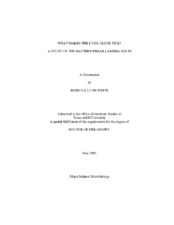| dc.description.abstract | The timing of host lysis is the only decision made in the bacteriophage lytic
cycle. To optimize timing, double-stranded DNA phages use a 2-component lysis
system consisting of a muralytic enzyme, the endolysin, and a small membrane protein,
the holin, which controls the timing of lysis. The best characterized holin gene to date is
the S gene of bacteriophage λ.
One unusual feature of the S gene is that it produces two proteins of opposing
function: the holin, S105, and the antiholin, S107. Raab et al isolated and characterized
a number of S mutants, but all of them expressed both the holin and the antiholin; it is
possible, then, that the true extent of the holin-holin interactions were masked by
interactions with the antiholin. Thus, a large number of S105 mutants were created, and
their phenotypes characterized in the absence of the antiholin. The interaction between
those mutants and the wild-type were examined in an attempt to better understand what
determines the timing of hole formation by S105.
S105 and S107 differ only by two amino acids at the N-terminus; S107 has an
additional Met-Lys sequence. Previous studies have shown that S107 may have a different topology to S105, where the N-terminus of S107 is located in the cytoplasm
and is cannot flip through the membrane because of the extra cationic side chain. This
study investigates the role of the N-terminal transmembrane domain of the S proteins in
terms of hole formation and its role in the antiholin character of S107.
Previous results suggest that S105 forms hole via a large oligomeric structure
termed the “death raft”. The death raft model states that after S105 is inserted into the
membrane, it forms “rafts”, which grow in size until a spontaneous channel forms
leading to depolarization of the membrane and hole formation. This study investigates
the pathway of hole formation at the single-cell level, using a C-terminal fusion of S105
and green fluorescent protein, and attempts to address several of the predictions posed
by the death raft model. | en |


